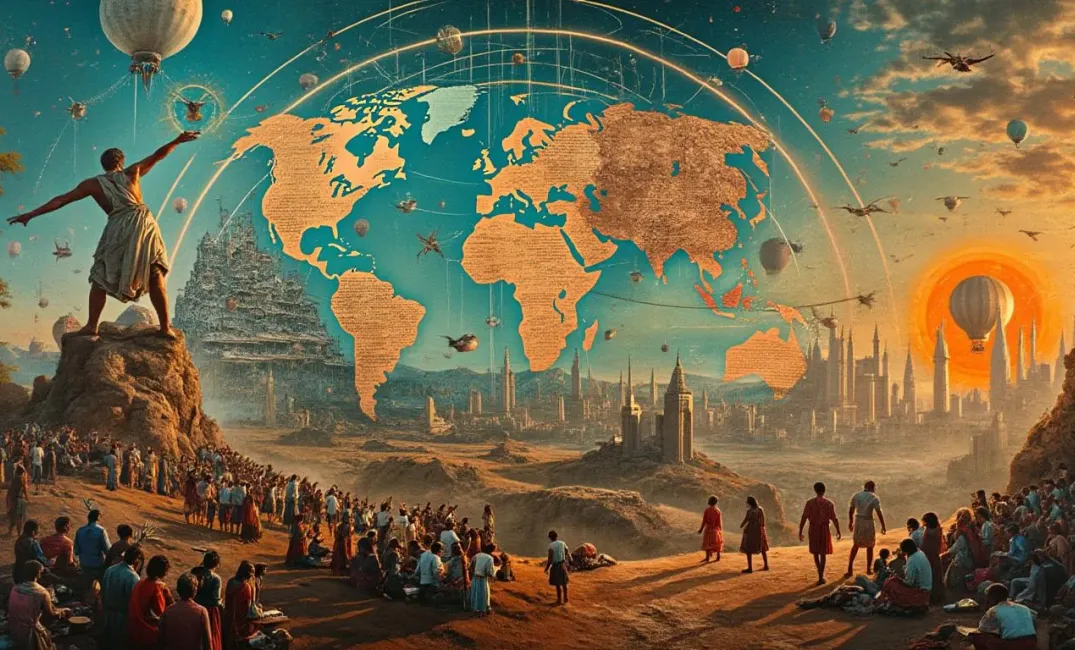Introduction: The Ever-Changing Mosaic
"Societies have always triumphantly displayed the very contradictions they seek to resolve." — Karl Marx
The tapestry of human society is uniquely intricate, constantly evolving through interactions, struggles, and innovations. This exploration delves into the dynamics of human societies, tracing their development from early tribes to modern, complex global human networks. Reflecting on the cultural, economic, and technological forces that shaped these social fabrics, we explore their legacies and implications for humanity's future.
Early Societal Structures
Tribal Communities: The Seeds of Complexity
- Hunting and Gathering: Early human societies were characterized by small, nomadic groups who relied on hunting and gathering. Social hierarchies were rudimentary, based around kinship and shared responsibilities.
- Communal Living: These communities laid foundations for social cohesion, characterized by communal sharing, tribal rituals, and oral traditions that preserved collective memory and fostered cohesion.
The Agricultural Revolution: Roots of Civilization
- Agricultural Development: Domestication of plants and animals revolutionized human livelihood, transitioning societies from nomadic lifestyles to settled agricultural communities.
- Societal Complexification: As food surpluses grew, so did populations, leading to the development of more complex social structures and eventually the emergence of villages and early cities.
Kingdoms and Empires: Dominance and Disparity
Rise of City-States and Empires
- Urban Centers: Civilizations such as Mesopotamia and ancient Egypt saw the emergence of city-states, centered around agricultural surpluses, trade, and centralized authority.
- Imperial Grip: Conquests led to the formation of empires, such as the Roman, Persian, and Chinese, each characterized by bureaucratic administrations, complex trade networks, and cultural integration.
Cultural and Economic Exchange
- Trade Routes: Routes like the Silk Road facilitated cultural exchange, connecting far-flung civilizations, while spreading ideas, religions, goods, and technologies.
- Cultural Hybridity: Empires fostered cultural hybridity, exemplified by the Hellenistic world, where Greek culture mingled with Egyptian, Persian, and Indian influences.
Societal Transformation in the Medieval Era
Feudalism and Its Discontents
- Feudal Structures: Medieval Europe was dominated by feudal systems characterized by vassalage and landholding, establishing hierarchical societal networks and localized economies.
- Rising Challenges: Feudal discontent spurred peasant revolts and movements toward more centralized state power in late medieval periods.
Islamic and Asian Flourishing
- The Islamic Golden Age: Islamic societies thrived, seeing scientific, philosophical, and artistic advancements that preserved and expanded upon ancient knowledge.
- Asian Dynasties: China under the Tang and Song dynasties saw innovations in technology and trade, shaping the continent's cultural and economic landscape.
The Enlightenment and Revolutionary Societies
The Age of Enlightenment
- Intellectual Awakening: Enlightenment thinkers promoted reason, individual liberty, and democracy, reshaping societal ideals and laying the groundwork for secular governance.
- Print and Dissemination: The proliferation of printed material democratized knowledge, empowering the common populace and influencing public discourse.
Revolutionary Changes
- Political Transformations: Revolutions, like the American and French, embodied Enlightenment principles, challenging monarchies and establishing new social contracts around liberty and equality.
- Industrial Impact: The Industrial Revolution transformed economies from agrarian-based to industrial, bringing urbanization, economic prosperity, and social challenges like labor exploitation and environmental degradation.
Modernity and Globalization
The Twentieth Century: Growth and Catastrophe
- Two World Wars: The 20th century was marred by global conflicts reshaping political landscapes, leading to the advent of international bodies like the United Nations.
- Technological Innovation: Unprecedented innovations, from the automobile to the internet, revolutionized communication, transportation, and everyday life, propelling societies into the modern age.
Global Networks and Cultural Exchange
- Cultural Interconnectivity: Globalization accelerated cultural exchanges, uniting distant societies through trade, digital communication, and shared challenges, fostering multicultural awareness and hybrid identities.
- Economic Globalization: Economies interconnected intricately, creating vast global networks that fueled growth but also highlighted disparities and dependencies, influencing migration, labor dynamics, and economic instability.
The Future of Human Societies
Societal Adaptation and Resilience
- Technological Integration: Emerging technologies, such as artificial intelligence and biotechnology, are poised to redefine industries, societies, and the human experience itself.
- Environmental Stewardship: Societies face compelling ethical imperatives for sustainability and environmental responsibility, requiring innovative global cooperation to address climate change and resource limitations.
Cultural Identity and Empowerment
- Cultural Revitalization: Amid globalization, societies seek to preserve heritage while embracing diversity, fostering inclusion, and empowering marginalized communities.
- Social Movements: Global activism and social movements continue to challenge societal norms, driving progress in human rights, gender equality, and more equitable socio-political systems.
Conclusion: The Mosaic of Human Societies
"In the end, a society's growth is determined not by its tools or weapons, but by its will to embrace change." — Unknown Sage
The legacy of human societies is one of dynamic evolution. From primal tribes to interconnected global communities, societies have continuously adapted, confronted disparities, and sought progress. While challenges persist, so does the potential for transformative solutions and visionary collaboration.
As humanity advances into uncharted cosmic realms, lessons from its social evolution provide both cautionary tales and aspirational paths. By fostering resilience, sustainability, and equity, societies can construct harmonious and thriving futures, bridging the divides of yesterday and seeding opportunities for tomorrow. This eternal pursuit—woven through diversity, creativity, and shared aspirations—propels humanity toward a more connected and enlightened existence.
EVOLUTION, HUMAN SOCIETIES, HISTORY, GLOBALIZATION, CULTURAL EXCHANGE, TECHNOLOGICAL INNOVATION, ENLIGHTENMENT

